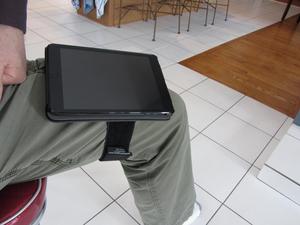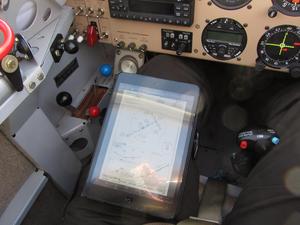Busy Weekend
- Details
- Written by Kevin Horton
- Hits: 2740
Altimeter and Altitude Encoder Woes
- Details
- Written by Kevin Horton
- Hits: 3576
I’ve been plagued with altimeter and altitude encoder issues, but I think I’m over them now. Several months ago, during a cold snap, the altimeter setting knob on my cheap, Chinese, Falcon altimeter became very stiff to turn. It took so much effort to turn it that it would unscrew off the shaft. Fortunately I’ve also got a Dynon EFIS with an altimeter, so I simply used that. I had chosen the Falcon altimeter as it was a lot cheaper than a “name brand” altimeter, and I could risk reliability problems with it as I knew I would also have the altimeter in the EFIS. Now that it had failed, I decided to spend the cash for a better quality altimeter. I bought a used United Instruments altimeter and had it overhauled.
Several weeks ago ATC reported that the altitudes reported by my transponder were about 200 ft lower than the altitudes shown by my two altimeters. This problem was evident again on all subsequent flights. It was quite clear that the ACK A–30 altitude encoder had drifted out of tolerance, for the second year in a row. It had worked fine from 2008 to early 2012, but it drifted down during 2012. I had it recalibrated at an overhaul shop, and it was OK for a few months, when it went out of tolerance again.
I had chosen the ACK altitude encoder, as it was the only low cost altitude encoder that seemed to get good reviews when I researched this in the early 2000s. It and the Ameri-King encoder sold for about $150, and the next cheaper ones went for about $1000. The $150 ACK encoder was worth a try.
After the second time it went out of tolerance, I did some more research. I found several people with similar complaints, and it seems that many of them work for 4–5 years, then continually drift out of tolerance. Drat!!
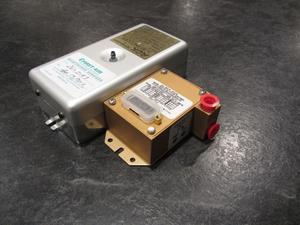 Fortunately there is now another low cost option on the market, the Trans-Cal SSD120, and it apparently has much better service history, and is pin-compatible with the ACK A–30. I ordered one from ACS. After receiving it, I was happy to see that the Trans-Cal encoder is much smaller and lighter than the ACK A–30 it was replacing.
Fortunately there is now another low cost option on the market, the Trans-Cal SSD120, and it apparently has much better service history, and is pin-compatible with the ACK A–30. I ordered one from ACS. After receiving it, I was happy to see that the Trans-Cal encoder is much smaller and lighter than the ACK A–30 it was replacing.
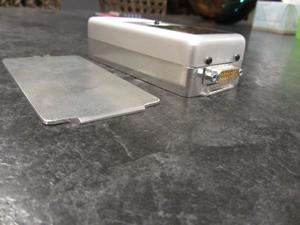 The ACK altitude encoder is secured in its mounting tray by a protruding lip at one end, and a knurled nut at the other. Trans-Cal sells an adapter plate that is bolted to the bottom of their altitude encoder - the adapter plate is the same size and shape as the ACK altitude encoder, so it can be secured in the same tray. But, ACS was out of stock on the adapter plates, so I made my own.
The ACK altitude encoder is secured in its mounting tray by a protruding lip at one end, and a knurled nut at the other. Trans-Cal sells an adapter plate that is bolted to the bottom of their altitude encoder - the adapter plate is the same size and shape as the ACK altitude encoder, so it can be secured in the same tray. But, ACS was out of stock on the adapter plates, so I made my own.
 The Trans-Cal encoder secured to the adapter plate.
The Trans-Cal encoder secured to the adapter plate.
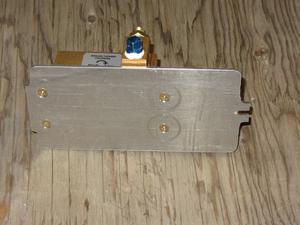 Flat head #6 screws secure the encoder to the plate.
Flat head #6 screws secure the encoder to the plate.
I was concerned that I after replacing the altimeter and altitude encoder, that I may be required to have another transponder “correlation” test done. The “correlation” or integration test, confirms that the altitudes reported by the altitude encoder match those shown on the altimeter. But, when I took a closer look at the regulations, I found that there is a “let” that covers my situation. The altimeter had recently been overhauled and calibrated by Woodlawn Instruments, and the altitude encoder was a new TSO’d unit, which had been calibrated at the factory, so AWM 571 Appendix F, para (k)(3) applies:
when the maintenance performed consists of the installation of a line replaceable unit (LRU) and the installed LRU is a known airworthy part, the integration test need not be accomplished if an operational test is carried out prior to flight.
Notwithstanding the above, I deemed it prudent to conduct a correlation test. I didn’t have access to an air data test set to apply calibrated suction to the static system during a ground test, so I did the correlation test in flight. AWM 571 Appendix F specifies the following altitudes to be checked when performing a “correlation” test:
- 500 ft
- 1,300 ft
- 2,700 ft
- 10,000 ft
- 14,800 ft
- 30,800 ft
Most altitude encoders transmit the altitude information via 9 - 12 wires using a modified Gray Code. These specific altitudes were chosen as they allow all data lines to be checked for both high and low (i.e. “1” or “0”). The altitude encoder transmits the pressure altitude in 100 ft increments, and the test consists of noting the altimeter indication at which the altitude encoder switches to and from the target altitude. E.g, when climbing, note the altimeter reading when the altitude encoder output switches from 1,200 ft to 1,300 ft, and from 1,300 ft to 1,400 ft. Note that the altimeter must be set to 29.92, so it is showing pressure altitude.
Given that the aircraft is based at Smiths Falls, at 415 ft elevation, it wasn’t practical to do a 500 ft test point. I also couldn’t legally check the 14,800 ft point without using oxygen. I looked at how the wires are used to transmit the altitude info, and saw that:
- only 8 of the wires were used for altitudes of 14,700 ft and below.
- replacing the 500 ft test point with one at 6,800 ft, would ensure that all 8 wires used below 14,800 ft were checked at both low and high by one of the test points. I.e., if one of the wires was stuck low or high, it would fail at least one of the test points.
Wire -> A1 A2 A4 B1 B2 B4 C1 C2 C4 D1 D2 D4 ALTITUDE 500 0 0 0 0 1 0 0 1 0 0 0 0 1300 0 0 0 1 1 1 1 0 0 0 0 0 2700 0 0 0 1 0 0 0 0 1 0 0 0 10000 0 1 1 1 0 1 0 1 0 0 0 0 14800 1 1 0 0 0 0 0 0 1 0 0 0 30800 1 0 0 0 0 0 0 0 1 0 0 1 6800 0 1 1 0 0 0 0 0 1 0 0 0
On Saturday, I checked the altitude encoder at 1300, 2700, 6800 and 10,000 ft, using the pressure altitude display on the Garmin GTX–327 transponder to tell me what the altitude encoder was saying. I found that the errors ranged from 35 to 50 ft, which is well within the maximum allowable error of 125 kt.
iPad Mini Kneeboard Solution
- Details
- Written by Kevin Horton
- Hits: 27156
I finally gave up on mounting my iPad Mini on the side of the cockpit, as glare was always a problem. Glare had not been a major issue with my first generation iPad on a kneeboard, so I decided to do the same with the iPad Mini. I was using a MyGoFlight iPad Kneeboard Sport with the original iPad, and it worked well, but it was pretty expensive ($100) for a piece of molded plastic. I didn’t relish spending another $100 for one for the iPad Mini, and their kneeboard wasn’t going to be released until Sun n Fun. I wanted a solution now.
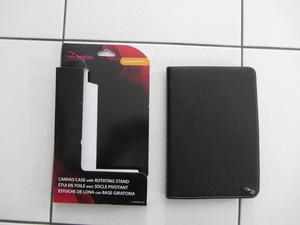
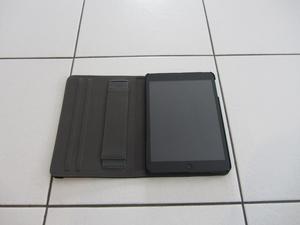

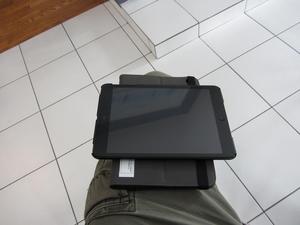
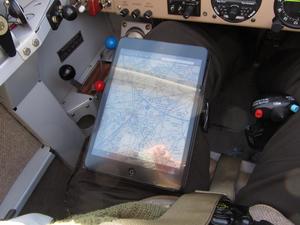
I’ll only use this case when I’m taking the iPad Mini in the aircraft, as it adds too much thickness. I’ll stick with the Apple Smart Cover for day to day use. But, it makes a great kneeboard. And it’ll protect the iPad well when I take it out of the aircraft. I like the $40 price much better than the likely $100 cost of the eventual MyGoFlight kneeboard. And it is available now.
Back Home Again
- Details
- Written by Kevin Horton
- Hits: 2985
It’s been a busy two weeks. A week ago Tuesday I flew to Phoenix, for two days of Global Express flight testing. Friday we ferried the test aircraft back to Wichita, and did more flight testing on Saturday and Tuesday. Wednesday I flew home. Thursday was a day in the office, always a bit of a let down after the hustle and bustle of flight testing. Yesterday I spent the day doing proficiency flying on a Transport Canada Cessna Citation.
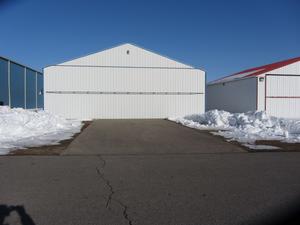 This morning I headed out to Smiths Falls to fly the RV–8. I was overjoyed to find that someone had plowed the snow that arrived while I was gone from in front of the hangar. Terry says we got a foot of snow at home while I was away, and it looks like Smiths Falls probably got even more than Ottawa did. Judging by the height of the snow banks it would have been a huge job if I had to move it myself. Thanks, Mr. Mystery Snow Plow Guy :)
This morning I headed out to Smiths Falls to fly the RV–8. I was overjoyed to find that someone had plowed the snow that arrived while I was gone from in front of the hangar. Terry says we got a foot of snow at home while I was away, and it looks like Smiths Falls probably got even more than Ottawa did. Judging by the height of the snow banks it would have been a huge job if I had to move it myself. Thanks, Mr. Mystery Snow Plow Guy :)
Today I while flying I experimented some more with the iPad Mini mounting solution. I was trialling it mounted on the left side of the cockpit, but I found that it overly hindered access to the frequency tuning knobs on the GNS430W. Today I tried it on the right side of the cockpit, using the RAM ball that I was using for my Garmin Aera 510 XM weather receiver. I put the Aera over on the left side, using the RAM ball that I had installed for the iPad Mini. I found that this worked much better. The iPad didn’t block the view or access of anything important. The Aera is much smaller than the iPad Mini, so I could put it a bit higher, and there was still good access to the GNS430W.
But, glare is still an issue. I had added a Targus Screen Protector iPad Mini AWV1246US, as it was recommended by several users on the VAF Forums. Without the screen protector there is objectionable glare from a wide range of iPad angles. The screen protector helps, in that there is a much smaller range of angles where the glare is problematic. But, I still find the screen dim if I am wearing my sunglasses on a bright sunny day. I was using my original larger iPad on a kneeboard on my thigh, and had no issues with glare or brightness. If I put the iPad Mini on my thigh the problem goes away. It looks like I need to buy an iPad Mini kneeboard. I didn’t buy one originally as I couldn’t find any that I liked. MyGoFlight, the company whose kneeboard I use with the original iPad, has just announced that they will release iPad Mini kneeboards at Sun n Fun. I’ll likely buy one if I make it down there.
Florida Vacation
- Details
- Written by Kevin Horton
- Hits: 2556
I got back home on Friday from almost two weeks in central Florida - five days for work, and another week of vacation. It was great to get away from winter, walk on the beach, etc. Among other things, we visited Kermit Weeks’ Fantasy of Flight collection (highly recommended) and the Merritt Island National Wildlife Refuge (huge variety of birds, alligators, etc). It was an unhappy, but expected, shock to see snow again when we got back.
I went out to the hangar on Saturday morning, expecting to have to clear a huge pile of snow from the big storm that came through while I was away. But, some good Samaritan had cleared it for me, and I only needed to deal with the 1/2" of loose, fluffy snow that had fallen Friday night. Thanks, whoever you are! I had a great RV–8 flight just before lunch, doing some practice instrument approaches at Ottawa.
Flying Friday
- Details
- Written by Kevin Horton
- Hits: 2222
It was pretty clear from the weather picture late last week that Friday would probably be the last flyable day for a bit, so I juggled my work schedule so I could take half a day off. I hoped to gather some more airspeed accuracy and cruise performance data, but it turned out to be too bumpy. It snowed on both Saturday and Sunday, so I definitely picked the right day to fly.
I’ve done a bit more thinking about the performance increase I’ve noted recently. The plots of speed vs power I posted last week rely on fuel flow to calculate engine power, using an method that Lycoming developed many years ago. I carefully calibrated the fuel flow indication back in 2008–2009, so it was accurate to ±0.5%, based on fuel used vs fuel added from the pump, over ten flights. It is possible that something has changed to affect the fuel flow calibration, so I’ve started collecting data to check it again. It would have to be under reading by about 10% now to fully explain the latest power vs speed relationship. I’m sure it isn’t anywhere close to that far off, but it could be out by a few percent.
